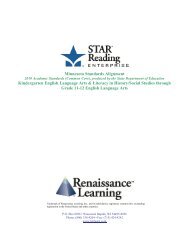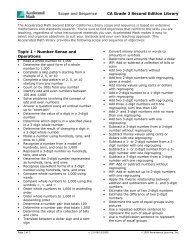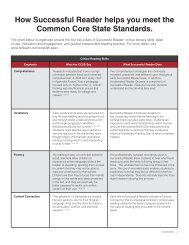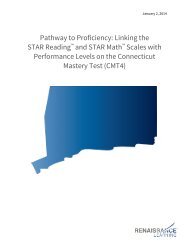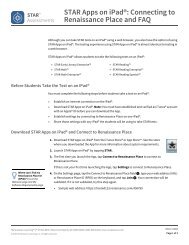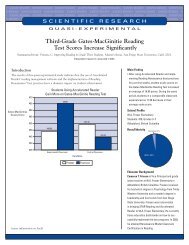Technical Manual - Renaissance Learning
Technical Manual - Renaissance Learning
Technical Manual - Renaissance Learning
Create successful ePaper yourself
Turn your PDF publications into a flip-book with our unique Google optimized e-Paper software.
NormingData AnalysisThe third step in the norming process was to employ post-stratification sampleweights to make the weighted data closely approximate the distributions of testscores within the national student population. The sample weights were appliedto all 48 combinations of stratification variables. Weighted scores were used tocompute the norms for both fall and spring at each grade level.Table 50 shows the fall and spring Scaled Score summary statistics by grade.Table 50:Summary Statistics on Fall and Spring Weighted Scaled Scores, STAR Early Literacy Enterprise NormingStudy—2014 (N = 134,830 Students)Fall ScoresSpring ScoresGradeSampleSizeScaledScoreMeansScaled ScoreStandardDeviationsScaledScoreMediansScaled ScoreMeansScaled ScoreStandardDeviationsScaledScoreMediansK 39,000 523 95 522 610 101 6111 66,840 635 106 631 738 90 7542 25,730 720 104 743 788 81 8103 3,260 766 101 803 818 70 838The sample sizes are identical for the fall and spring scores within each grade inTable 50 since students were selected for the norming sample if there werematched fall and spring scores from the same group of students.The norm-referenced scores are determined from both the fall and spring testingperiods used for the norming. Table 61 (see page 151) presents an abridgedversion of the Scaled Score to Percentile Rank conversion tables for STAR EarlyLiteracy Enterprise. The actual table in the software includes data for each of themonthly grade placement values 0.0–2.9. Since the norming of STAR Early LiteracyEnterprise occurred in the months of August, September, and October of theschool year for the fall testing period and April, May, and June of the school yearfor the spring testing period, empirical values were thus established for the falland spring norming periods. The data for the remaining monthly values wereestablished by interpolation between the two empirical testing periods. Table 61(see page 151) presents Scaled Score to Percentile Rank conversion by grade (atmonth 7 of the school year) as an abridgment of the larger table included in thesoftware. The expanded table provided in the software provides normativeinformation that is most relevant for the specific time period in which eachstudent takes the STAR Early Literacy Enterprise assessment.Grade Equivalent (GE) scores for each grade and each month of the school yearwere computed by interpolation between the median fall and spring ScaledScores for each grade. The interpolated values for the Grade Equivalent valuesSTAR Early Literacy<strong>Technical</strong> <strong>Manual</strong>105





